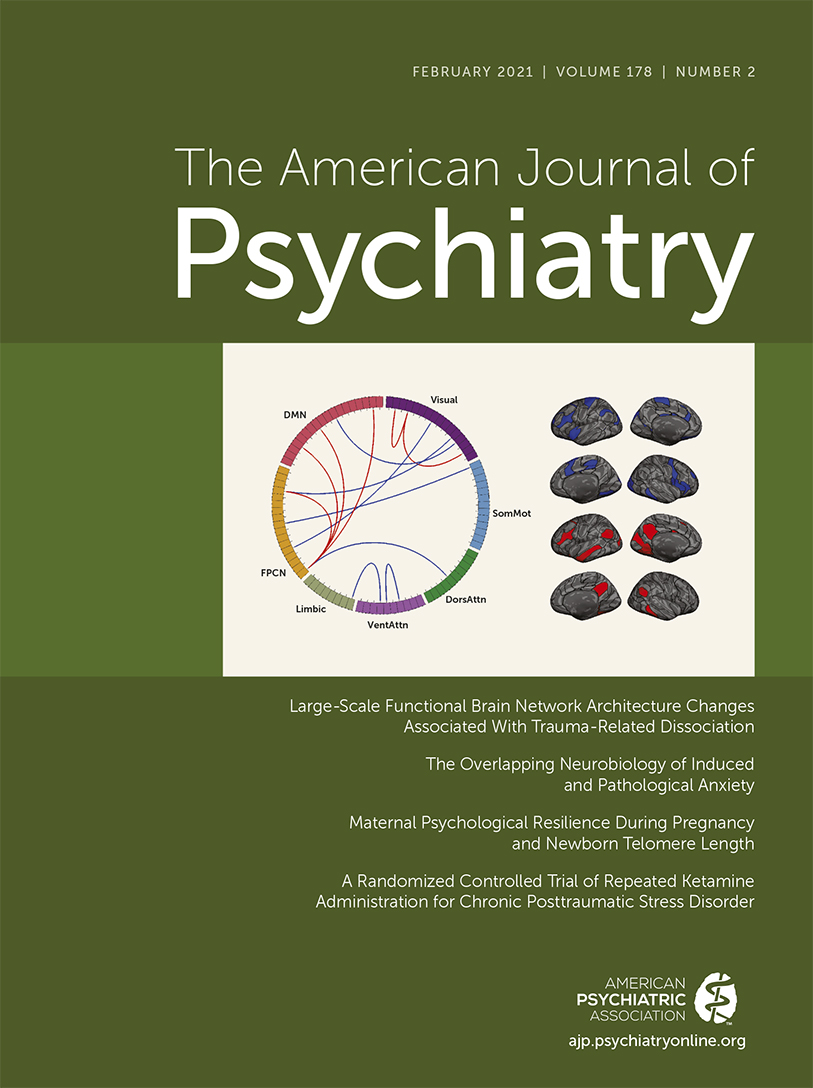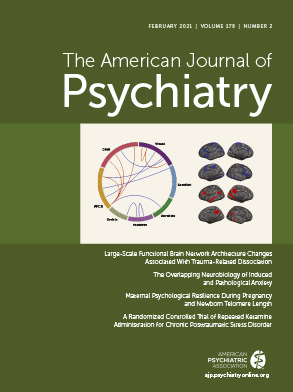Recent advances in neuroscience research on stress have had only minimal impact on the diagnosis and treatment (
1,
2) of posttraumatic stress disorder (PTSD). Clinical disagreement may impede successful basic-to-clinical translation and contribute to stalled therapeutic advances. Nearly four decades after the introduction of PTSD in DSM-III, disputes persist regarding its definition (
3,
4), as reflected in DSM-5 and in ICD-11. In other psychopathological arenas, a focus on core symptom dimensions provides a nidus around which basic and clinical research can coalesce. By focusing on core dimensions, research can proceed despite lingering disagreement about categorical syndrome definitions. In this commentary, we outline one such domain-focused approach for PTSD research.
A focus on the unique symptom domain of intrusive and involuntary recollection and reexperiencing of the trauma in the here and now could guide mechanisms-oriented research and provide concrete strategies for enhancing treatment of posttraumatic psychopathology. Preliminary genetic, imaging, and experimental therapeutics research on memory intrusion and reexperiencing already provides unique insights into PTSD (
5–
8). However, deeper, systematic, and more extensive translational focus is needed to maximize clinical impact. Specifically, highlighting memory pathology involving intrusive reexperiencing of trauma, particularly occurring in the here and now, could focus PTSD research and therapeutics on a unique core feature of the disorder and bridge biological and cognitive neuroscience research by examining narrow, clearly defined processes under experimentally controlled conditions.
Importantly, vivid mental images also occur in other conditions. For example, imagery-related forms of intrusive rumination are common in anxiety, mood, and obsessive-compulsive disorders. However, these forms of imagery differ clinically from posttraumatic imagery and intrusive memories in that only the latter involve distinct here-and-now qualities. Eventually, translational research on memory intrusion and traumatic reexperiencing may further clarify the uniqueness of imagery-related phenomena in many conditions, based on both clinical presentation and associated biology (
9). Focusing translational PTSD research on memory disruption, as captured by the symptom domain of intrusive traumatic reexperiencing, could initiate efforts to achieve such clarification (
10). In this commentary, we address two considerations surrounding the adoption of a narrow focus on memory and associated intrusive traumatic reexperiencing in PTSD research: one related to the breadth of PTSD symptomatology, and the other related to the unique clinical relevance of intrusive traumatic reexperiencing.
Multidomain Expressions of Psychopathology
Focusing on any single symptom domain in PTSD would fail to capture the wide array of maladaptive behaviors linked to traumatic stress (
11). DSM-5 groups 20 symptoms into four clusters, which generate numerous combinations of symptoms that could qualify for the PTSD diagnosis (
12). The ICD-11 criteria include only three symptom clusters and remove nonspecific symptoms that overlap with other disorders (e.g., trouble concentrating, sleep problems, depression). By using a narrower set, ICD-11 aims to differentiate PTSD more clearly from other frequently co-occurring conditions and nonspecific symptoms. Nonetheless, ICD-11 still includes mandatory diagnostic symptoms strongly associated with other disorders, including avoidance and hyperarousal, key components of all anxiety disorders.
PTSD resembles other complex syndromes defined solely by coaggregating clinical symptoms that manifest along multiple domains. In such multidomain, clinically defined conditions, a focus on any one domain typically fails to capture all aspects of the disorder. When multidomain phenotypes like PTSD are defined with high diversity, any focused research approach will neglect some disorder domains. Unfocused approaches, in contrast, may fail to achieve traction in applying neuroscience insights to improve diagnosis and treatment. Such failure may arise at least partly because broadly targeted research efforts contrast with approaches in some areas of neuroscience, which progressively target specific behavior domains. Finally, existing translational research programs already target many domains relevant to PTSD, which would not be targeted in focused research on memory perturbation specifically involving intrusive reexperiencing. These other domains include perturbations in attention orienting, extinction learning, threat responsivity, and components of executive functions, such as inhibitory control. These features occur prominently in PTSD but also in anxiety and obsessive-compulsive spectrum disorders. Also targeted by translational research are symptoms of anhedonia, irritability, and dysphoria, which occur in the mood disorders as well as following trauma. Focused research in these cross-disorder domains suggests that advances in translational neuroscience for a shared domain can be applied to many conditions, including trauma-related, mood, anxiety, and obsessive-compulsive disorders. Another symptom domain, associated with distinct perturbations in autobiographical memory, exhibits more unique relations to traumatic stress: intrusive and vivid reexperiencing of the trauma in the here and now. For this domain, less elaborated translational research programs exist. Failure to mount such a program may slow identification of novel treatments for a core feature of PTSD.
Finally, current PTSD definitions do not highlight symptoms uniquely related to traumatic exposure. Nonunique symptoms, such as avoidance, may relate to broad ranges of distressing events associated with multiple syndromes. These nonunique symptoms can reflect adaptations related to apprehension. Specifically, in PTSD, avoidance often relates to apprehension about involuntary traumatic reexperiencing, much in the way that avoidance in social anxiety disorder reflects adaptations related to apprehension about social encounters. Advantages follow from a specific targeting of memory dysfunction that involves intrusive reexperiencing. Such a focus allows experimental therapeutics research on PTSD to narrowly target and dissociate memory dysfunction as distinct from effects on nonspecific symptoms associated with apprehension, avoidance, hyperarousal, depression, or sleep problems.
The Prominence of Intrusive Reexperiencing Following Trauma
The second key issue in this commentary concerns placing emphasis on the prominence of a specific form of memory dysfunction in PTSD. This emphasis enables intrusive reexperiencing of traumatic events to be targeted in a focused translational neuroscience program. Traumatic reexperiencing can lead to extreme fear, horror, and fear of losing control when reliving the trauma (
13). Focusing on this domain could identify targets uniquely related to trauma. It seems appropriate to target this domain in research and therapy when the symptoms persist for 1 month and when they cause distress or impairment in ways that involve two core features: symptoms that arise after exposure to extremely threatening or horrific events, and symptoms that involve a specific form of memory dysfunction manifesting as persistent intrusion with reexperiencing of the traumatic event(s).
This form of memory dysfunction in PTSD occurs along a continuum of intrusiveness. At one relatively low extreme, such dysfunction manifests as memories that are described as vivid and intrusive. At the other extreme, such dysfunction manifests as memories that are described as flashbacks or trauma-related nightmares (see the online supplement for definitions of these symptoms and additional clarifications).
We label this core process the “intrusive traumatic reexperiencing domain” to provide a conceptual tool with potential clinical and scientific utility.
Table 1 summarizes features of this domain in various large samples of veterans, active-duty soldiers exposed to combat, and civilian patients (see the
online supplement for sample characteristics and data extraction methods). Importantly, we provide these data to assist in localizing the intrusive traumatic reexperiencing domain within the extant diagnostic space relating to symptomatic reactions following traumatic exposure currently defined by PTSD. It remains to be seen whether this domain is indeed relevant or useful as a syndrome. We define this domain so that future research may test its utility.
Scientists can quantify the intrusive traumatic reexperiencing domain by using three PTSD criteria listed in DSM: B1 (recurrent, involuntary, and intrusive distressing memories of the traumatic event), B2 (recurrent distressing dreams in which the content and/or affect of the dream are related to the traumatic event), and B3 (dissociative reactions [e.g., flashbacks] in which the individual feels or acts as if the traumatic event were recurring). Many trauma-exposed individuals have negative-valence traumatic memories involving emotional and physical reactions. One important feature that differentiates normal and pathological memories of traumatic events concerns the intrusive, involuntary nature of pathological memories. When extreme, such pathological memories manifest with a reliving in-the-moment quality and uncontrolled re‐experiencing of salient traumatic-memory elements. This domain excludes DSM-5 symptoms outlined in sections B4 (intense or prolonged psychological distress at exposure to internal or external cues that symbolize or resemble an aspect of the traumatic event) and B5 (marked physiological reactions to internal or external cues that symbolize or resemble an aspect of the traumatic event). Because these two symptom categories are broadly defined, their omission excludes common memory-related phenomena that follow trauma. Moreover, excluding the B4 and B5 categories highlights the centrality of uncontrolled memory intrusion in the B1, B2, and B3 categories, which represents only one aspect of the B4 and B5 criteria.
Data in the online supplement show that most patients meeting DSM-IV or DSM-5 criteria for PTSD also manifest symptoms in the intrusive traumatic reexperiencing domain. Accordingly, research with a focus on intrusive reexperiencing applies to large groups of patients meeting criteria for PTSD. Moreover, approximately 10% of trauma-exposed individuals who fail to meet DSM criteria for PTSD suffer from intrusive memories and reexperiencing symptoms that would be identified by the intrusive traumatic reexperiencing domain. Finally, the data also suggest that the symptoms found in the B4 and B5 categories are of limited diagnostic utility when considering unique responses to combat-related trauma.
In conclusion, focusing on the intrusive traumatic reexperiencing domain may uncover unique therapeutic targets. Unfortunately, intrusive traumatic reexperiencing is investigated less thoroughly than other PTSD symptom domains, such as perturbations in attention, extinction learning, threat responsivity, and depression, which occur prominently in PTSD but also in other major disorders. A focus on the intrusive traumatic reexperiencing domain could move science and clinical research toward understudied aspects that are at the core of traumatic experiences, affording novel means to understand mechanisms and treatment options. Preliminary data from therapeutic, genetic, and neuroimaging studies suggest the potential utility of this focused approach. Beyond highlighting the need to mount a broader systematic program of research on this symptom domain, we have also provided data here on the clinical prominence of the domain among diverse populations with trauma-related psychopathology and traumatic exposure. A focused targeting of this domain could facilitate efficient biobehavioral clinical-mechanistic research, identify currently underrecognized patient subgroups, and guide novel treatment development.

